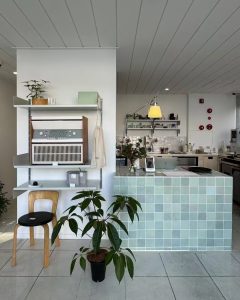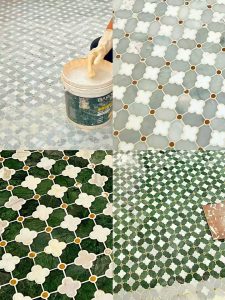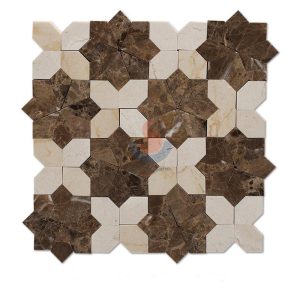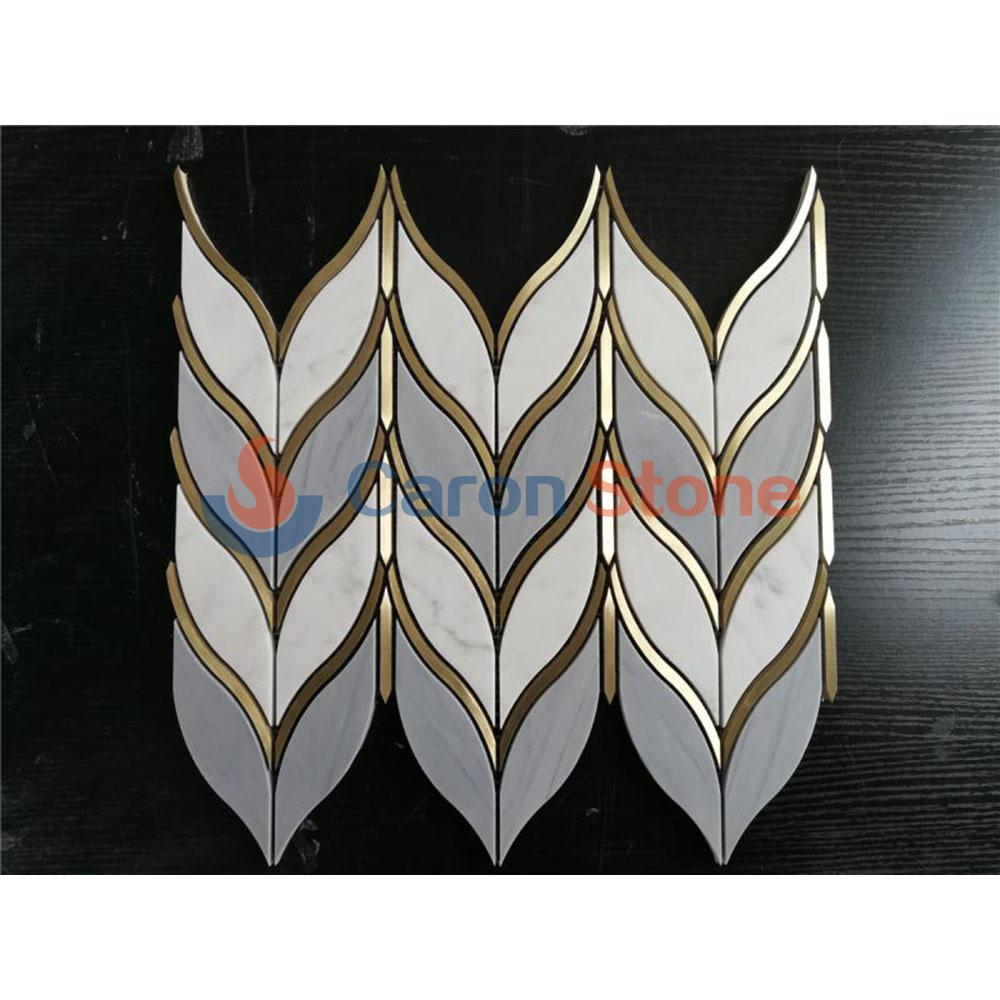Marble mosaic has become one of the indispensable materials in modern architectural decoration with its unique decorative effect and diverse color matching. This material can not only add artistic atmosphere to the interior space, but also provide a durable and easy-to-maintain surface. This article will introduce the construction process of marble mosaic floor in detail, including key steps such as paving, reinforcement and grinding and polishing to ensure the construction quality and the final decorative effect.

Kitchen with marble mosaic
Characteristics and construction of traditional mosaics
Traditional mosaics are mostly made of ceramic materials, which are fired at high temperatures to form hard and wear-resistant particles. The particles of this material are brittle and high in density, smooth on the front and rough on the back, and have good acid and alkali resistance. The early paving method was relatively simple, but it could ensure the firm bonding of the mosaic to the base layer and show a good decorative effect. The paving, reinforcement and decorative effects of traditional mosaics still provide valuable references for modern construction.
Characteristics and paving status of modern marble mosaics
Modern marble mosaics are more advanced in material selection and production technology, but they also face problems such as inconsistent particle thickness and unclear gaps. These problems directly affect the decorative effect and overall strength of mosaics. The current paving and installation methods often cannot fully solve these problems, resulting in limited decorative effects and service life of mosaics. Therefore, improving the construction methods of modern marble mosaics is the key to improving construction quality and decorative effects.

Marble Mosaic Tile Grout
Construction process
1. Preparation before paving: Before construction, it is necessary to ensure that the working surface is clean and flat, and properly wetted to facilitate the subsequent laying of adhesive materials. In addition, the perforation of the backing mesh and the coating of the interface agent are also essential steps, which help to enhance the adhesion between the mosaic and the base.
2. Scrape the base slurry: Scraping the glue-containing slurry on the base surface is a key step to ensure the adhesion of the mosaic to the base. It is necessary to correctly estimate the amount of base slurry to ensure that the thickness of the base slurry can both bond the backing mesh and squeeze into the gaps between the particles, thereby forming a strong bond.
3. Arrangement of components: Before paving, the mosaic panels must be pre-arranged according to the pattern requirements, the accuracy of the pattern splicing must be verified, and the size of the joints and the size of the component installation surface must be reserved to prevent the removal after the wrong paving and the falling of particles.
4. Paving: Lay the mosaic panels flat and compact them with appropriate tools to ensure the bonding between the base slurry and the particles. Due to the need for polishing in the later stage, the size of the overall component paving should be 0.2cm higher to reserve polishing space.
5. Product protection: The newly laid components should be prevented from being stepped on and contaminated; cement mortar and adhesive materials should be prevented from contaminating the mosaic surface and gaps; sharp objects should be prevented from scratching the particles. These protective measures are essential to ensure the construction quality and the final decorative effect.
6. Bottom slurry maintenance: The bottom slurry of mosaics has a long maintenance period. Ensure a sufficient maintenance period to release the water vapor in the bottom slurry to meet the requirements of the next construction process. Insufficient maintenance may lead to insufficient bottom slurry strength and affect the bonding effect of the mosaic.
Material selection suggestions
1. Base bonding material: Selecting a water-based adhesive with good strength and strong bonding force as an additive material for the interface agent and cement can significantly improve the bonding strength between the mosaic and the base. Or you can directly purchase adhesive-containing adhesives to enhance the bonding strength with the back mesh of the component.
2. Mosaic selection: When purchasing mosaics, special attention should be paid to the consistency of particle thickness and the standardization of gaps. Particles with consistent thickness help reduce the workload of later grinding, while standardized gaps help improve the overall aesthetics of the mosaic.
3. Grouting material selection: The selection of grouting materials should be based on the design requirements and the width of the gaps between mosaic particles. If the project requirements are high and the gaps between particles are small, you can choose solvent-based liquid glue with good transparency and no yellowing as grouting material; if the gaps are uniformly large, you can choose a certain amount of liquid glue and caulking glue with brightness after grinding.

Black and white marble with brass fan design mosaic tile
The construction process of marble mosaics is crucial to the final decorative effect. Through careful construction process and material selection, it can be ensured that the mosaic floor is both beautiful and durable, showing its unique artistic charm and practical value. With the development of the building decoration industry, the requirements for construction technology are also constantly increasing. The construction team needs to constantly learn and adapt to new construction technologies to meet the increasing decoration standards.
People also ask:
What styles of marble mosaics are there?
Marble mosaic is a popular choice in home decoration design due to its unique artistic temperament and ability to create a variety of patterns through the splicing of small pieces. This combination of craftsmanship and imagination creates a perfect blend of art and workmanship, offering numerous opportunities for home décor design. Designers must not only understand the craftsmanship behind these designs but also apply them skillfully to create unique spaces for customers. Marble mosaic appeals at the junction of creativity and workmanship since its pattern design can be classic geometric or personalised.





